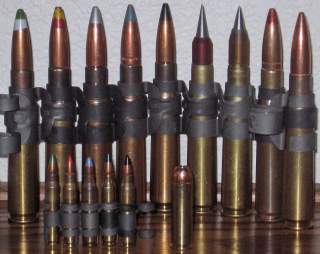The Mad Scientists at DARPA Want to Make Smart .50 Caliber Bullets That Can Be Guided
Amazing?
Snipers, armed with ballistic data based on previous engagements, can often predict how a bullet will travel under local conditions.
One of the most challenging roles in ground units is that of a military sniper. Military snipers must take long distance shots with precision rifles, often doing a fair amount of math in their heads to make a bullet reach its target. A new guided-bullet technology, however, promises to make longer distance shots a little easier by installing guidance systems in bullets.
The mission of the sniper is to take out targets at ranges farther than your typical rifleman, from five hundred yards out to two thousand yards. Snipers rely on specialized training, accurized, high power rifles and quality optics to reliably hit targets that are often mere specks on the horizon. These targets typically include anything from specialized enemy troops (engineers, heavy weapon operators) to command, control, and communications targets (radio operators, officers.) Snipers may also engage material targets, such as antennas, aircraft and light vehicles.
(This first appeared in July 2018.)
In addition to mere distance, snipers must contend with the technical limitations of their weapons and physics to make long range shots. Once they exit the barrel, bullets immediately start slowing down as gravity begins to exert an influence. This causes bullets to travel in a gradual downward arc. Bullets are also vulnerable to weather conditions, particularly wind, and are increasingly vulnerable to environmental conditions as they lose velocity.
Snipers, armed with ballistic data based on previous engagements, can often predict how a bullet will travel under local conditions. A sniper, for example, would know how much a 7.62-millimeter bullet would drop at a range of eight hundred yards, and how a six-mile-an-hour crosswind will blow the bullet off course. Armed with this knowledge snipers can adjust their weapons accordingly to place a bullet on target at ranges of up to a mile—or more.
A sniper can reliably overcome the effects of distance, though the act of collecting needed data (distance, wind speed, humidity) to determine course corrections delays the shot. One method of simplifying this is to use a ballistic computer that automatically collects the data and projects an adjusted aiming point onto a sniper scope display. Another is to make the bullet itself a guided weapon.
The Defense Advanced Research Projects Agency, or DARPA, has taken the latter approach. EXACTO, or Extreme Accuracy Tasked Ordnance bullets turns .50 caliber bullets into guided rounds capable of zeroing in on a target. Although DARPA is mum on how it does this, other sites report that the technology involves optical sensors in the nose of the bullet and fins capable of adjusting the bullet’s flight path in the tail. The optical sensor apparently homes in on a spot illuminated by a laser designator. The guidance system is similar to laser-guided weapons such as the Maverick and Hellfire laser-guided missiles. The bullet is even capable of making some remarkably sharp course corrections.
DARPA claims that the system is so easy to use that during testing, “a novice shooter using the system for the first time hit a moving target.” This leads us to an advantage the EXACTO technology has over ballistic computer technology: while ballistic computers can turn ordinary weapons into precision guided ones, once the bullet is fired the computer can no longer assist the shot. If the target moves during the bullet’s relatively brief—but not insignificant flight time—the shot misses. EXACTO, on the other hand, continues to guide the bullet toward the target, to the point where it is capable of engaging a moving target.
EXACTO technology promises to revolutionize sniping. Snipers can now engage targets more quickly and with greater accuracy at longer ranges, allowing them to do their jobs more safely and efficiently. EXACTO is unaffected by sudden environmental changes, such as a sudden gust of wind. A guided bullet capable of hitting moving targets could be very useful against drones and unmanned aerial vehicles.
Recommended: Forget the F-35: The Tempest Could Be the Future
Recommended: Why No Commander Wants to Take On a Spike Missile
Recommended: What Will the Sixth-Generation Jet Fighter Look Like?
The technology does have a few downsides. If EXACTO does use a laser designator to mark a target that laser is visible under the right circumstances, alerting those being targeted. Even worse, the laser beam will point directly to the the person lasing the target. The system will also need a long-lasting power supply, as a sniper may need to wait for hours for the opportunity to take a shot.
In 2014, DARPA announced it was working toward EXACTO system in a deployable weapon that weighs no more than forty-six pounds with a fourteen-hour power supply. The guided round should have the same ballistic performance as the M33 .50 caliber bullet beyond ranges of three hundred meters. The hardest part of creating a deployable weapon system may be the cost: DARPA wanted a weapon inexpensive enough to actually deploy with the troops.
DARPA has gone quiet on EXACTO and has not released any details since 2014. This suggests one of two things: the program was defunded in favor of other projects or it has entered classified service with some arm of the Pentagon, possibly U.S. Special Operations Command. Given the obvious utility of such a weapon the latter seems more likely. EXACTO is an ideal weapon for long distance shooting in places such as northern Iraq, Syria and Afghanistan. It’s possible EXACTO, or some modernized version thereof, is in service right now somewhere around the world.
Kyle Mizokami is a defense and national-security writer based in San Francisco who has appeared in the Diplomat, Foreign Policy , War is Boring and the Daily Beast . In 2009, he cofounded the defense and security blog Japan Security Watch . You can follow him on Twitter: @KyleMizokami.
Image: Wikimedia

